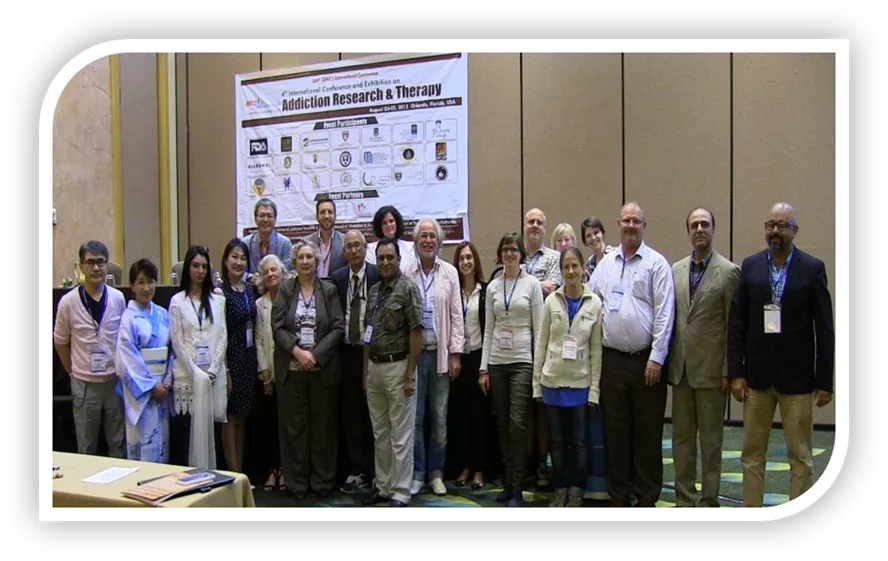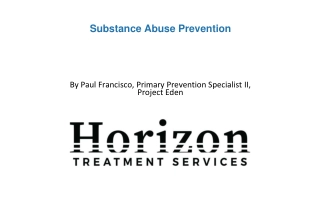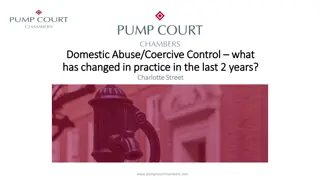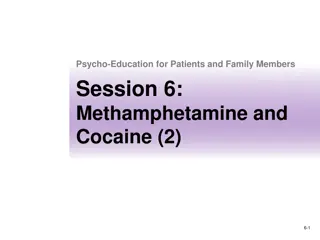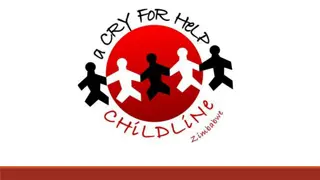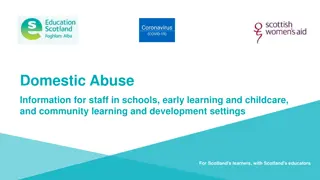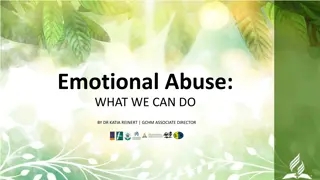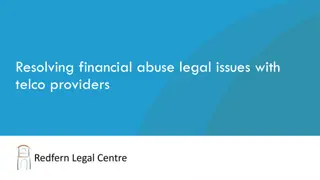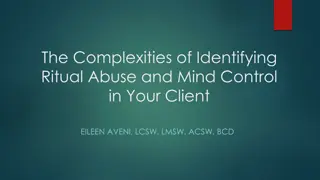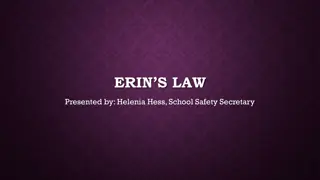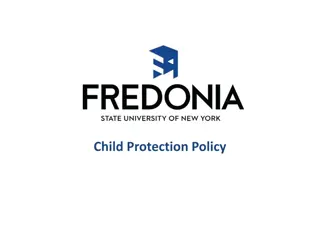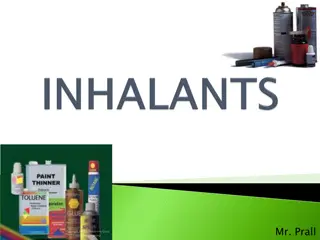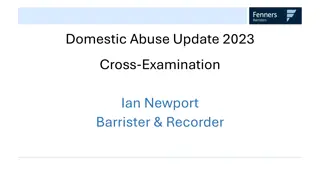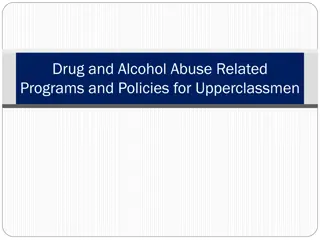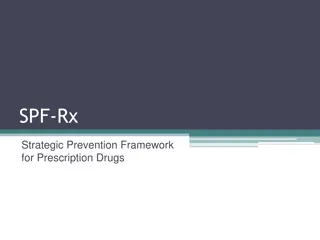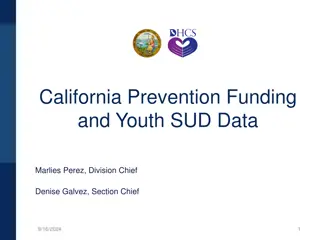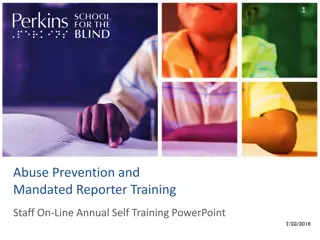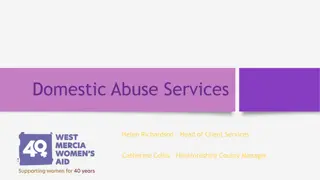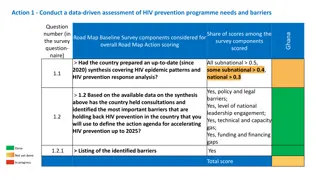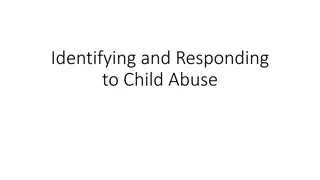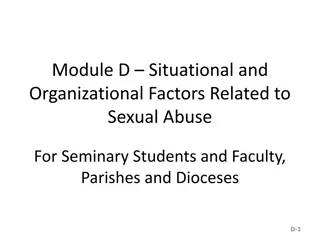Inhalant Abuse: Risks, Effects, and Prevention
Inhalant abuse is a widespread issue, with volatile substances being inhaled to achieve psychoactive effects. This form of substance abuse poses significant toxicological and social hazards, often affecting marginalized populations such as neglected street children. The accessibility, affordability, and ease of concealment make inhalants particularly dangerous, especially among adolescents. Various examples of inhalants include volatile solvents, aerosols, anesthetics, and nitrites. Prevention efforts are crucial to address this least-studied class of psychoactive agents.
Download Presentation

Please find below an Image/Link to download the presentation.
The content on the website is provided AS IS for your information and personal use only. It may not be sold, licensed, or shared on other websites without obtaining consent from the author. Download presentation by click this link. If you encounter any issues during the download, it is possible that the publisher has removed the file from their server.
E N D
Presentation Transcript
Addiction Therapy 2015 Florida, USA August 03-08, 2015 Alaaeldin A Elkoussi
TOXICOLOGICAL AND SOCIAL HAZARDS OF SOLVENT INHALANT ABUSE Alaaeldin ElKoussi , Ph.D Department of Pharmacology, College of Medicine, Assiut University, Assiut, EGYPT alaaeldine@hotmail.com.
Today, inhalation of volatile substances is practiced worldwide although there is marked variability in the type and pattern of substances abused. Although research concerning inhalant abuse epidemiology, neurobiology, treatment and prevention has accelerated in recent years; still they remain the least-studied class of psychoactive agents.
WHAT ARE THE INHALANTS ? Inhalants are breathable vapors or gases that produce psycho- active effects when abused. They include: - Volatile organic solvents - Fuel gases - Nitrites - Anesthetic gases 4 10/11/2024 SOLVENT INHALANT ABUSE
EXAMPLES OF INHALANTS - Volatile Solvents AND Gases: Glue, Paint Thinner, Gasoline, Gas Lighters, Nail Polish Remover, Correction Fluid. - Aerosols: hair sprays - Anesthetics: Nitrous Oxide, Ether - Nitrites: Amyl, butyl and Isobutyl Nitrites. (Room Odorizers) 5 10/11/2024 SOLVENT INHALANT ABUSE
IN MOST COUNTRIES INHALANTS ARE THE CHEAP TOXIC ADDICTING SUBSTANCES OF THE POOR!! WHO CARES??
Most Common Among Innocent Neglected Street Children
NOT Always The Case in Developed Countries !!!
WHY INHALANTS ARE THE MOST DANGEROUS? 1. Readily Available and Easily Obtained 2. Easily Concealed 3. Cheap 4. Popular 5. More common among Adolescents and Children 9 10/11/2024 SOLVENT INHALANT ABUSE
WHY INHALANTS ARE THE MOST DANGEROUS? 6. Not Illegal !! 7. Stepping Stone/Gateway to Other Dangerous Addicting substances 8. Extremely Toxic 9. Severe Withdrawal Symptoms 10.No Available Treatment Methods 11. Detoxification is very difficult 12. Relapses are Very High 10 10/11/2024 SOLVENT INHALANT ABUSE
PREVALENCE IN DIFFERENT COUNTRIES According to the 2005 World Drug Report, 52 North America has the highest rate of inhalant treatment admissions (18%) Eastern Europe (5%) Africa and South America (4%) Australia/New Zealand and Asia (2%) and Western Europe (1%).
Size and Patterns of Solvent inhalant Abuse in Different Countries 1. USA 22 MILLIONS reported a history of VSM 2. SOUTH AMERICA : Life time prevalence range from: 2.67% in Paraguay 16.55% in Brazil. More prevalence among street children and high school students.
Size and Patterns of Solvent inhalant Abuse in Different Countries 3. MEXICO 1% In the general population , 7% among high school students and more among street children 4. UPPER EGYPT: 91% of street children, one third of those Misusing glue.
Size and Patterns of Solvent inhalant Abuse in Different Countries 5. CLOMBIA : School children (mean age: 14.8 years) reported: 16% VSM Exposure Opportunity, 3% past year use, 7-10% positive VSM intentions. 6. EASTERN SLOVAKIA: 90% Of Roma (gypsy) worker youth were chronic toluene users. 15% of users younger than 10 y/o..75%between 10 and 25 y/o.
Size and Patterns of Solvent inhalant Abuse in Different Countries 7. ISRAEL: Past month use reported by 7.5% of school students age 12-18 together with illicit drug use, smoking, internet gambling, being drinking and school truancy (nonappearance /absence from school) 8. INDIA: Whitener fluid containing toluene among homeless children . mean age 12.8 years (6-14 y/o). most children used other substances consequently: tobacco, alcohol, cannabis, heroin (less extent).
Size and Patterns of Solvent inhalant Abuse in Different Countries 9. NIGERIA Lifetime, annual, and current prevalence of inhalant use among selected Nigerian secondary school students: Lifetime use 25.7% Use in past year 13.4% Use in past month 20%
Size and Patterns of Solvent inhalant Abuse in Different Countries 10. SOUTH AFRICA. out of 1,234 male and 602 female students, 13 percent and 5 percent, respectively, had used an inhalant at least once. Use in the past month was reported to be 1.5 percent and 1.2 percent, Three males (0.2 percent) used inhalants daily or nearly daily. Of the 198 males who used inhalants [in the past year], 86 percent sniffed petrol, 1.5 percent glue, 4 percent aerosols and 8.5 percent did not specify the substance used. Only about 32 percent of the males and 42 percent of the females regarded inhalants as harmful. Most did not know that inhalants caused any harm to users. Similar responses were recorded for other drugs, including tobacco and alcohol.
Size and Patterns of Solvent inhalant Abuse in Different Countries 12. JAPAN Solvent abuse among high school children in Chiba Prefecture near Tokyo. 1.5% of all students reported use of solvents at least once in the past. This percent might be an underestimate, since the survey was conducted among students who were in classrooms at the time of the survey and these might have been relatively healthy students who attend school on a regular basis. Many solvent abusers are thought to be absent or dropouts from school. The survey also suggested that nonusers have more satisfying school and family lives than solvent users.
SUBSTANCES MISUSED IN DIFFERENT COUNTRIES OTHER COUNTIRES Gasoline/ Petrol Toluene Glue Car exhaust Kerosene Paint thinner Lighter fluid Sprays Ether Chloroform Nitrous oxide DEVELOPED COUNTRIES Shoe polish Toluene Amyl nitrite Correction fluid Glue Gasoline Halothane Spray paints Nitrous oxide Propane Other aerosolesprays
MOST COMMON Motives and PERCEPTIONS in different countries It is not illegal does not subject abusers to arrest by the police It is cheep and easily available To attain "social freedom" To break "social barriers", or "norms" To improve abusers self-esteem They make abusers forget their problems Experimenting Some abusers consider It a proof of masculinity
MOST COMMON MOTIVES AND PERCEPTIONS IN DIFFERENT COUNTRIES Increased activity level, Enhanced physical strength Decreased shyness Intentional decreased appetite Sleep induction Feeling good Getting a high, numbing of physical and psychological pain Feeling dreamy and lighthearted Overcoming sadness and negative feelings Avoiding withdrawal Enjoying the sweet taste and fruity smell
SEQUENCE OF EVENTS IMMEDIATELY FOLLOWING INHALATION Rapid Absorption/Lipid soluble Instants Rush Euphoria CNS Depression Loosing Touch with Surroundings Loss of Self-Control Violent Behavior 22 10/11/2024 SOLVENT INHALANT ABUSE
SEQUENCE OF EVENTS IMMEDIATELY FOLLOWING INHALATION Nausea Unconsciousness Giddiness Loss of Inhibition Loss of appetite Hallucinations (In Higher doses) Sudden Death 23 10/11/2024 SOLVENT INHALANT ABUSE
OTHER SIGNS AND COMMON TOXIC ACTIONS 1.Loss of motor skills 2.Slurred Speech 3.Tachycardia and Palpitations/ Bradycarida 4.Seizures 5.Vomiting , diarrhea 6.Abdominal pain 24 10/11/2024 SOLVENT INHALANT ABUSE
OTHER SIGNS AND COMMON TOXIC ACTIONS 7. Dryness and Redness Around the Mouth and Nose 8. Paints or Stains on Body or Clothing 9. Chemical Breath Odor 10.Drunk, Dizzy 11. Sneezing 12.Coughing 25 10/11/2024 SOLVENT INHALANT ABUSE
OTHER SIGNS AND COMMON TOXIC ACTIONS 13. Wheezing 14. Excessive Salivation 15. Anxiety, Excitability and Irritability 16. Suffocation 17. Fire-related Injury 18. Coma, Brain Damage and Lead Poisoning 19. SUDDEN SNIFFING DEATH SYNDROME (SSDS) 26 10/11/2024 SOLVENT INHALANT ABUSE
GENERAL HAZARDS The majority of abusers do not know that SVA is harmful >85% It is mainly among youth who are the future Cheap, available and toxic legal substances Economic, Socioeconomic, Health and Security risks Gateway to other addicting substances Abusers are Future drug dealers Unawareness from authorities and public No strict actions are taken No prevention, control or treatment strategies NEED FOR Evaluation-driven research
SOME HARMS!!! Burning of lungs Tuberculosis & other infections Stomach ailment Kidney stones Vomiting blood Blackened teeth Constriction of the heart !! Weak bones Weight loss Reduced thinking power Aggressive behavior and violence Changed appearance Money loss Involvement in risky & criminal activities.
RISK FACTORS 1. Domestic violence 2. Dictatorial father 3. Divorced parents 4. Presence of step parents 5. Migrant status 6. Substance abuse in the family 7. Association with delinquent peers. 8. Poverty
Sequence of Actions Immediately Following Inhalation Rapid Absorption/Lipid soluble Instants Rush Euphoria CNS Depression Loosing Touch with Surroundings Loss of Self-Control Violent Behavior 30 10/11/2024 SOLVENT INHALANT ABUSE
Sequence of Actions Immediately Following Inhalation Nausea Unconsciousness Giddiness Loss of Inhibition Loss of appetite Hallucinations (In Higher doses) Sudden Death 31 10/11/2024 SOLVENT INHALANT ABUSE
OUR STUDIES MAIN OBJECTIVES the Investigate substance abuse among street children in Upper Egypt. Track the trends and patterns of abuse among street children . Identify the chemical , toxicological and neurotoxicological the cheapest and most commonly abused substance which is a glue called "Kolla". magnitude of properties of
Data Collection Methods included: Self-report surveys, Interviews Informant reports Case study methods, Questionnaires Focus group discussions
Chemical & Pharmacological Investigation of the Most Commonly Abused Inhalant KOLLA Physicochemical properties of "Kolla" using GC-MS. Effect of "Kolla" Inhalation on Locomotor Activity Effect on motor coordination (Rotarod Test) Effect on lipid peroxidation Histopathological changes in kidney , liver and brain Effect on brain glutamate Other CNS & CV effects & toxicity.
Chemicla Analysis of Kolla Analysis by (GC/MS) Parameter Concentration (mg/g) (+S.D.) Percent recovery Toluene P-Xyline Pseudocumene Cumene Ethylbenzene n-Hexane 28.861( 0.015) 23.621 ( 0.024) 12.512 ( 0.029) 6.183 ( 0.022) 5.899 ( 0.031) 5.111( 0.029) 98.13 99.29 101.89 98.33 101.55 99.38 n-Octane Decane n-propylbenzene n-Nonane Dodecane Pyrrolidine Isobutylbenzene Undecane 4.190 ( 0.030) 2.572 ( 0.017) 3.617 ( 0.020) 2.980 ( 0.011) 1.555 ( 0.016) 0.886 ( 0.016) 0.247 ( 0.021 1.455 ( 0.033) 100.05 98.55 100.38 102.08 98.55 99.03 101.28 101.15
Pharmacological & Toxicological The Inhalation Box
Pharmacological & Toxicological Results Change in locomotor activity (no. of movements/20 min) after glue inhalation (1000 ppm) 160 140 120 Before Number of movemements 100 After 80 60 40 20 0 1 2 3 4 5 6 7 8 9 10 Day
Pharmacological & Toxicological Results
Pharmacological & Toxicological Results Changes in locomotor activity (no.of movement/20 min) after glue inhalation (8000 ppm) 500 450 400 350 300 movements Before Number of 250 After 200 150 100 50 0 1 2 3 4 5 6 7 8 9 10 Day
Effect on lipid peroxidation 1800 1600 1400 1200 MDA (nm/g) 1000 Control 1000 ppm 4000 ppm 8000 ppm 800 600 400 200 0 Cortex Cerebellum Influence of glue on lipid peroxidation.MDA=Malondialdhyde level in cortex and cerebellum
CONCLUSIONS The exact number of street children either in Egypt or in its upper (southern) part is still hard to determine. A vast majority of the street children in Upper Egypt abuse a glue called "Kolla" on habitual basis without knowing anything about its hazards to their health. The street children use the glue because: it is not illegal and does not subject them to arrest by the police, because it is cheep and easily available and to attain "social freedom", to break "social barriers", or "norms" and to improve their self-esteem. Chemical analysis of "Kolla" revealed that it contains more than 10 inhaled toxic substances. This mixture of solvents has more toxic effects than individual solvent. Toluene represents large percentage of glue (28.861mg/g glue), other substances are present as n- Hexane, n-Octane, Ethylbenzene and p-Xylene. 1. 2. 3. 4.
CONCLUSIONS 5.Repeated daily inhalation of "Kolla" for 10 days exerted a biphasic response on locomotor activity of rats with an initial depression followed by inhalation. 6."Kolla" increases MDA level in some brain regions as cortex and cerebellum indicating its deleterious effect on lipid peroxidation. 7.Repeated daily inhalation of "Kolla" for 10 days exerted a biphasic response on locomotor activity of rats with an initial depression followed by inhalation. "Kolla" increases MDA level in some brain regions as cortex and cerebellum indicating its deleterious effect on lipid peroxidation 8.Further investigations are currently carried out to determine the effects of "Kolla" on glutamate level in brain as well as its histopathological toxicity effects on liver, brain and kidney of experimental animals.
Meet the eminent gathering once again at Addiction Therapy 2016 Miami, USA October 06-08, 2016 Addiction Therapy 2016 Website: addictiontherapy.conferenceseries.com
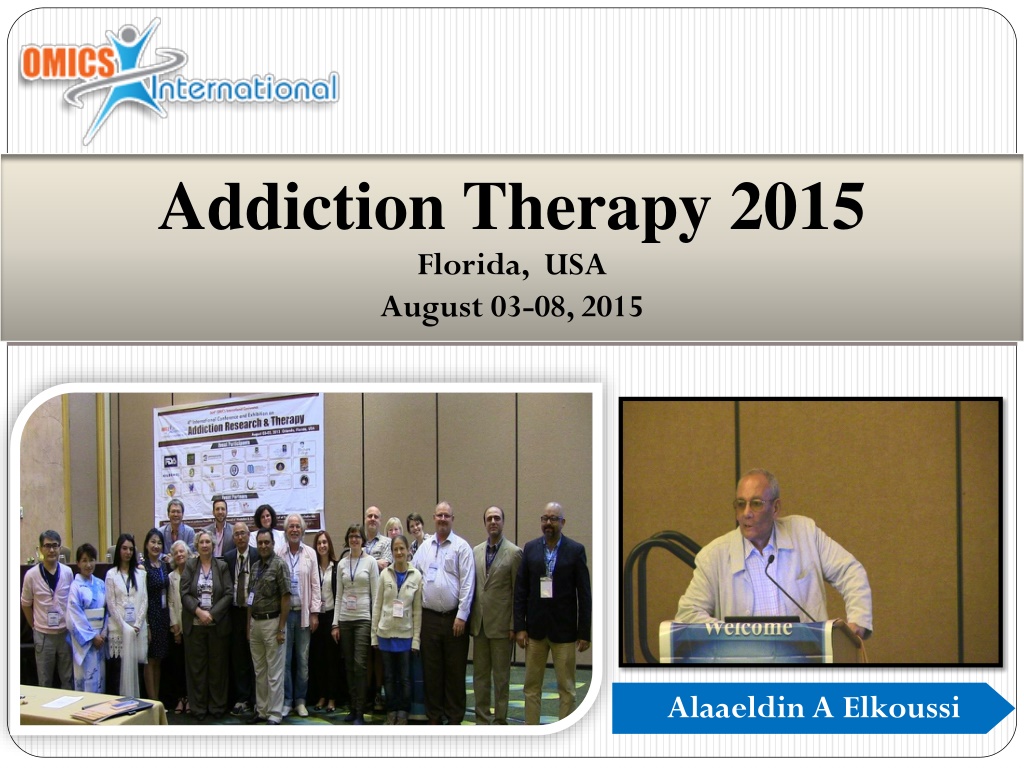
 undefined
undefined







